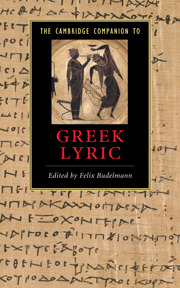Book contents
- Frontmatter
- Introducing Greek lyric
- Part I: Contexts and topics
- Part II: Poets and traditions
- 8 Iambos
- 9 Elegy: Forms, functions and communication
- 10 Alcman, Stesichorus and Ibycus
- 11 Alcaeus and Sappho
- 12 Anacreon and the Anacreontea
- 13 Simonides, Pindar and Bacchylides
- 14 Ancient Greek popular song
- 15 Timotheus the New Musician
- Part III: Reception
- Chronology of select melic, elegiac and iambic poets
- Further Reading
- Glossary
- List of works cited
- Index
15 - Timotheus the New Musician
from Part II: - Poets and traditions
Published online by Cambridge University Press: 28 May 2010
- Frontmatter
- Introducing Greek lyric
- Part I: Contexts and topics
- Part II: Poets and traditions
- 8 Iambos
- 9 Elegy: Forms, functions and communication
- 10 Alcman, Stesichorus and Ibycus
- 11 Alcaeus and Sappho
- 12 Anacreon and the Anacreontea
- 13 Simonides, Pindar and Bacchylides
- 14 Ancient Greek popular song
- 15 Timotheus the New Musician
- Part III: Reception
- Chronology of select melic, elegiac and iambic poets
- Further Reading
- Glossary
- List of works cited
- Index
Summary
Timotheus was born in Miletus about 450 and died about 360 BCE. His professional activity can be traced from about 415 BCE into the fourth century. Timotheus is said to have written nineteen kitharodic nomoi, eighteen dithyrambs, twenty-one hymns, an unknown number of enkômia, thirty-six preludes (prooimia) 'and some other pieces'. Of the kitharodic nomoi there survive: about a third of the Persians; a single line of Artemis (unless this is a hymn), and nothing more than the titles of Nauplius and Niobe. Certainly dithyrambs and known by title only are Mad Ajax, Elpenor, Birthpangs of Semele and Skylla. Possibly dithyrambic is Cyclops, of which six lines survive. We also know the titles Laertes and Sons of Phineus, both of unknown genre.
Though little verse and no music remains, there is plentiful evidence to show how the ancients reacted to Timotheus. From antiquity to modernity these reactions have been extreme. Indeed the history of Timotheus is the story of his reception - and at the heart of the story is the controversial 'New Music'. Timotheus' activity spans the most volatile and most creative period in the history of Greek music. He overlaps with other innovators, conspicuous for their efforts to develop the musical potential of song: Melanippides (c. 475–415 BCE), Euripides (c. 480–406 bce), Phrynis (c. 460–400 bce), Agathon (c. 450–399 bce), Cinesias (c. 450–390 bce), Telestes (c. 450–390 bce), Crexus (c. 440–380 bce) and Philoxenus (c. 435–380 bce). Of all these poets the ancients considered Timotheus the most innovative. He soon came to symbolise the innovations of New Music generally.
- Type
- Chapter
- Information
- The Cambridge Companion to Greek Lyric , pp. 277 - 294Publisher: Cambridge University PressPrint publication year: 2009
- 23
- Cited by



